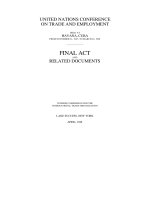Presenters Final Slides
Bạn đang xem bản rút gọn của tài liệu. Xem và tải ngay bản đầy đủ của tài liệu tại đây (2.03 MB, 50 trang )
Low-Income Housing Tax Credit Funds:
Investment Opportunities for Banks
Wednesday September 10, 2008
2:00 p.m. – 3:30 p.m. EDT
Low-Income Housing Tax Credit Funds:
Investment Opportunities for Banks
Presented by:
Barry Wides, Moderator
OCC
Dana Boole, Presenter
CAHEC
Richard A. Floreani, Presenter
Ernst & Young
2
Speaker Biographies
Welcome by John C. Dugan
Open Remarks by Barry Wides
Power Point Presentation
Questions and Answers
3
John C. Dugan
John C. Dugan
Comptroller of the Currency
OCC
John C. Dugan was sworn in as the 29th Comptroller of the Currency on August 14, 2005.
The Comptroller of the Currency is the administrator of national banks and chief officer of the
Office of the Comptroller of the Currency (OCC). The OCC supervises 1,900 federally chartered
commercial banks and about 50 federal branches and agencies of foreign banks in the United States, comprising more
than half the assets of the commercial banking system. The Comptroller also serves as a director of the Federal
Deposit Insurance Corporation, the Federal Financial Institutions Examination Council, and the Neighborhood
Reinvestment Corporation.
Prior to his appointment as Comptroller, Mr. Dugan was a partner at the law firm of Covington & Burling, where he
chaired the firm’s Financial Institutions Group. He specialized in banking and financial institution regulation. He also
served as outside counsel to the ABA Securities Association.
He served at the Department of Treasury from 1989 to 1993 and was appointed assistant secretary for domestic finance
in 1992. While at Treasury, Mr. Dugan had extensive responsibility for policy initiatives involving banks and financial
institutions, including the savings and loan cleanup, Glass-Steagall and banking reform, and regulation of governmentsponsored enterprises. In 1991, he oversaw a comprehensive study of the banking industry that formed the basis for
the financial modernization legislation proposed by the administration of the first President Bush.
4
John C. Dugan
From 1985 to 1989, Mr. Dugan was minority counsel and minority general counsel for the U.S. Senate Committee
on Banking, Housing, and Urban Affairs. There he advised the committee as it debated that Competitive Equality
Banking Act of 1987, the Proxmire Financial Modernization Act of 1988, and the Financial Institutions Reform,
Recovery, and Enforcement Act of 1989.
Among his professional and volunteer activities before becoming Comptroller, he served as a director of Minbanc,
a charitable organization whose mission is to enhance professional and educational opportunities for minorities
in the banking industry. He was also a member of the American Bar Association’s committee on banking law, the
Federal Bar Association’s section of financial institutions and the economy, and the District of Columbia Bar
Association’s section of corporations, finance, and securities laws.
A graduate of the University of Michigan in 1977 with an A.B. in English literature, Mr. Dugan also earned his J.D.
from Harvard Law School in 1981. Born in Washington, DC in 1955, Mr. Dugan lives in Chevy Chase, MD, with his
wife, Beth, and his two children, Claire and Jack.
5
Barry Wides
Barry Wides
Deputy Comptroller
OCC Community Affairs
Barry Wides is the OCC’s Deputy Comptroller for Community Affairs, in which capacity he leads a
department of community development professionals located in Washington, D.C., and the four
OCC
districts. The Community Affairs staff is responsible for outreach to banks and their community
partners, the administration of the “Part 24” public welfare investment authority, the development of
policy, and the creation and distribution of educational materials on community development issues.
Prior to joining the OCC in 1999, Mr. Wides was Director of Affordable Housing Sales at Freddie Mac. He led a nationwide
sales team responsible for developing products and strategies to achieve the company’s congressionally mandated
affordable housing goals. He previously served as Deputy Director of the Resolution Trust Corporation’s Affordable
Housing Program. Mr. Wides began his career in Washington as a presidential management intern and budget examiner
at the Office of Management and Budget.
Barry is a Certified Public Accountant and holds a B.S. in accounting and an M.B.A. from Indiana.
6
Dana Boole
Dana Boole
President and CEO
Community Affordable Housing Equity Corporation
Raleigh, North Carolina
Dana Boole is the President and CEO of Community Affordable Housing Equity Corporation
(CAHEC). He has been with CAHEC since 2001. His duties include the management of
CAHEC’s operations and oversight of its fund raising efforts throughout the United States
with primary focus in the mid-Atlantic and southeastern states. His management
CAHEC’s overall strategy
and operations;include
(2) accountability
for CAHEC’s growth, furtherance of its mission, and oversight
responsibilities
(1) guiding
of its financial condition; and (3) provision of the leadership, vision, and resources necessary to maintain the company’s
strategic competitive advantage. Fund-raising responsibilities include (1) managing the company’s activities for federal,
state, and historic tax credit funds; (2) diversifying efforts to include multi-investor, private label, and historic-only funds; and
(3) sourcing investors through a combination of direct originations and broker relationships.
Mr. Boole came to CAHEC from Edison Capital Housing Investments in Boston. As Acquisitions Director at Edison, he
focused primarily on equity syndication in the eastern United States. Before joining Edison, he held positions as Vice
President of Acquisitions for National Partnership Investments Corp. and as a commercial real estate consultant for the
Leggat Company.
Mr. Boole received his bachelor of arts in economics from the University of Vermont and his MBA in finance and strategy
from the F.W. Olin School of Business at Babson College. Mr. Boole currently serves as a Class B Director for the Federal
Reserve Bank of Richmond and is a standing member of its Planning and Operations Committee and Audit Committee.
7
Richard Floreani
Richard A. Floreani
Senior Manager
Tax Credit Investment Advisory Services
Ernst & Young
Richard A. Floreani is Senior Manager for the Tax Credit Investment Advisory Services group at the
accounting firm of Ernst & Young. In that position, he advises institutional clients on
risk analysis and investment evaluation in a majority of housing credit investment funds syndicated.
He has 17 years of experience counseling clients on tax credit transactions. Since joining Ernst &
Young in 1996, he has focused on representing institutional investors in transactions that earn them tax credits for
investing in low-income housing, historic rehabilitation, community development (“new markets”), and renewable energy.
Mr. Floreani also advises banking and insurance clients on regulatory matters relating to tax credit investments and tax
policy evaluation. He also helps investors and tax credit syndicators benchmark performance and improve operational
efficiency. In addition, he produces Understanding the Dynamics, the industry’s annual survey of housing tax credit
investment and property performance.
Prior to joining Ernst & Young, Mr. Floreani was employed at Affirmative Investments, Inc., a development and financial
consulting firm specializing in housing tax credit transactions. During his tenure, he prepared financial projections,
conducted real estate due diligence, structured legal and tax issues, and negotiated financing terms on behalf of
affordable housing developers.
Mr. Floreani graduated with a B.A. degree (cum laude) from Boston University and currently serves on
the board of directors of AIDS Housing Corporation.
8
Welcome
John C. Dugan
Comptroller of the Currency
9
Opening Remarks
Barry Wides
Deputy Comptroller
OCC Community Affairs
10
10
Topics To Be Covered
Dana Boole
President and CEO
Community Affordable Housing
Equity Corporation
Raleigh, North Carolina
How do tax credits differ from tax deductions?
Why invest in housing tax credits?
Who invests in housing tax credits?
What are the methods of fund investing?
What are the primary benefits of fund
investing?
CAHEC Funds and Portfolio
How does a bank evaluate a fund manager and
fund?
How are housing tax credits calculated?
What are the underwriting and pricing
considerations?
11
11
What Is a Credit versus a Deduction?
$1 of credit reduces $1 of taxes owed by $1
$1 of deduction reduces $1 of taxes owed by the
applicable tax rate (i.e. 35%)
12
12
Example of Credit versus Deduction
Gross Income
Credit
Deduction
$1,000,000
$1,000,000
Less Deduction
($100,000)
Adjusted Income
$1,000,000
$900,000
Taxes @ 35%
$350,000
$315,000
Less Housing
Credits
($100,000)
Taxes Owed
$250,000
13
13
$315,000
Why Invest in Housing Credits?
Increases after tax earnings
Provides financial return on investment (credits
and operating losses)
Provides financial performance similar to bond
instruments
Receives consideration under the Investment
Test of the CRA
Provides safe and affordable housing to
residents
Provides community banks with an additional
vehicle for their investment strategy
14
14
Who Invests in Housing Credits?
2007
(~ $9 Billion Market)
Projected 2008
(~ $5 Billion Market)
Other
10%
Insurance
10%
Banks
40%
GSEs
40%
15
15
Methods to Fund Investing
Fund-Type
National
Investment-Type
Multi
Private
Label
16
16
Regional
StateSpecific
Primary Benefits of Fund Investing
Risk Sharing and Diversification – investments often extend over
many properties and states
CRA Consideration – investments may be targeted for specific
regions, states, and in some instances, counties
Underwriting Expertise – fund managers select projects for
inclusion in funds after meeting strict criteria for market, financial
and tax guidelines
Asset and Compliance Management Expertise – fund managers
are well versed in Section 42 and applicable housing law
Flexible Investment Amounts – can invest as little as $500,000
17
17
Sample Fund Structure
SYNDICATOR AND FUND
MANAGER
Upper-Tier General Partner
INVESTOR A,
an Upper-Tier
Limited
Partner
.01%
INVESTOR B,
an Upper-Tier
Limited Partner
33.33%
INVESTOR C,
an Upper-Tier
Limited Partner
33.33%
33.33%
SAMPLE LIMITED PARTNERSHIP (aka FUND)
99.99%
DEVELOPER
Lower-Tier
General
Partner
99.99%
DEVELOPER
Lower-Tier
General
Partner
.01%
.01%
Lower-Tier
Limited
Partnership
99.99%
Lower-Tier
Limited
Partnership
18
18
DEVELOPER
Lower-Tier
General
Partner
.01%
Lower-Tier
Lower-Tier
Limited
Limited
Partnership
Partnership
CAHEC’s CEF XIII (6/30/08)
Raised $95 million (10 investors)
Invested in 24 assets (~ 1,300 residential units)
Invested in seven mid-Atlantic and southeast states
25% of assets had state credits
50% of assets were new construction (balance were
rehabilitations)
25% of assets were family developments (balance were
elderly)
19
19
CAHEC’s Portfolio (6/30/08)
22 LIHTC and 11 historic tax credit funds
Seven states
205 assets
9,017 residential and 58 commercial units
$675,000,000 subscribed and under management
No incidence of recapture or foreclosure
20
20
Evaluating a Fund Manager
Financial Condition – strength of balance sheet to maintain
longevity during lean economic conditions
Business Strategy – sound core competencies and business
direction that lead to a sustainable competitive advantage
Employees – seasoned staff, low attrition and sound leadership
Acquisitions and Underwriting – guidelines that are
consistent with current industry standards
Asset Management – ability to monitor ongoing compliance
and provide investment data using industry accepted
performance criteria
21
21
Evaluating a Fund Manager (continued)
Risk Management – proven ability to manage and mitigate
problem properties
Investor Reporting – consistency in meeting financial
deadlines (audit and tax returns) of corporate investors
Geographic Knowledge – breadth and depth of portfolio
from a diverse economic base
Portfolio Performance – ability to meet target yields and
benefits
Investor Base – proven ability to grow and diversify
sources of capital which allows a fund to hedge against
sector downturns
22
22
Evaluating a Fund
CRA – affirm (through your regulator) that the fund’s target
investments will satisfy the needs of your next CRA
examination under the Investment Test
Properties – undertake due diligence of the fund, the
syndicator, and the properties being acquired through internal
resources or third parties
Accounting – secure approval from internal accounting and
external auditors as to the non-CRA impact of the investment
on your financials
23
23
Evaluating a Fund (continued)
Tax – ensure that your expected tax liability is sufficient to
make use of the tax benefits (now can be used against the
Alternative Minimum Tax (AMT)), carry backs and carry
forwards permitted.
Investor Profile – determine the fund manager’s track record
in working with (past and current funds) investors whose size
and needs align with yours
References – identify institutions (similar to your size and
geographic needs) that have previously worked with the fund
manager and learn about the institutions’ past experiences
24
24
How Is the Amount of a Project’s
Housing Credit Calculated?
Units
Multiplied by Unit
Cost (including
Land)
50
Multiplied by Tax
Credit Rate
9.00%
$80,000
Annual Allocation
$315,000
Total Cost
$4,000,000
Land Cost
($400,000)
Non-Depreciable
Expenses
($100,000)
Depreciable Basis
Multiplied by
Available Credits
Multiplied by Credit
Price
Available
Equity
$3,500,000
25
25
10 years
$3,150,000
$0.83
$2, 614,500









